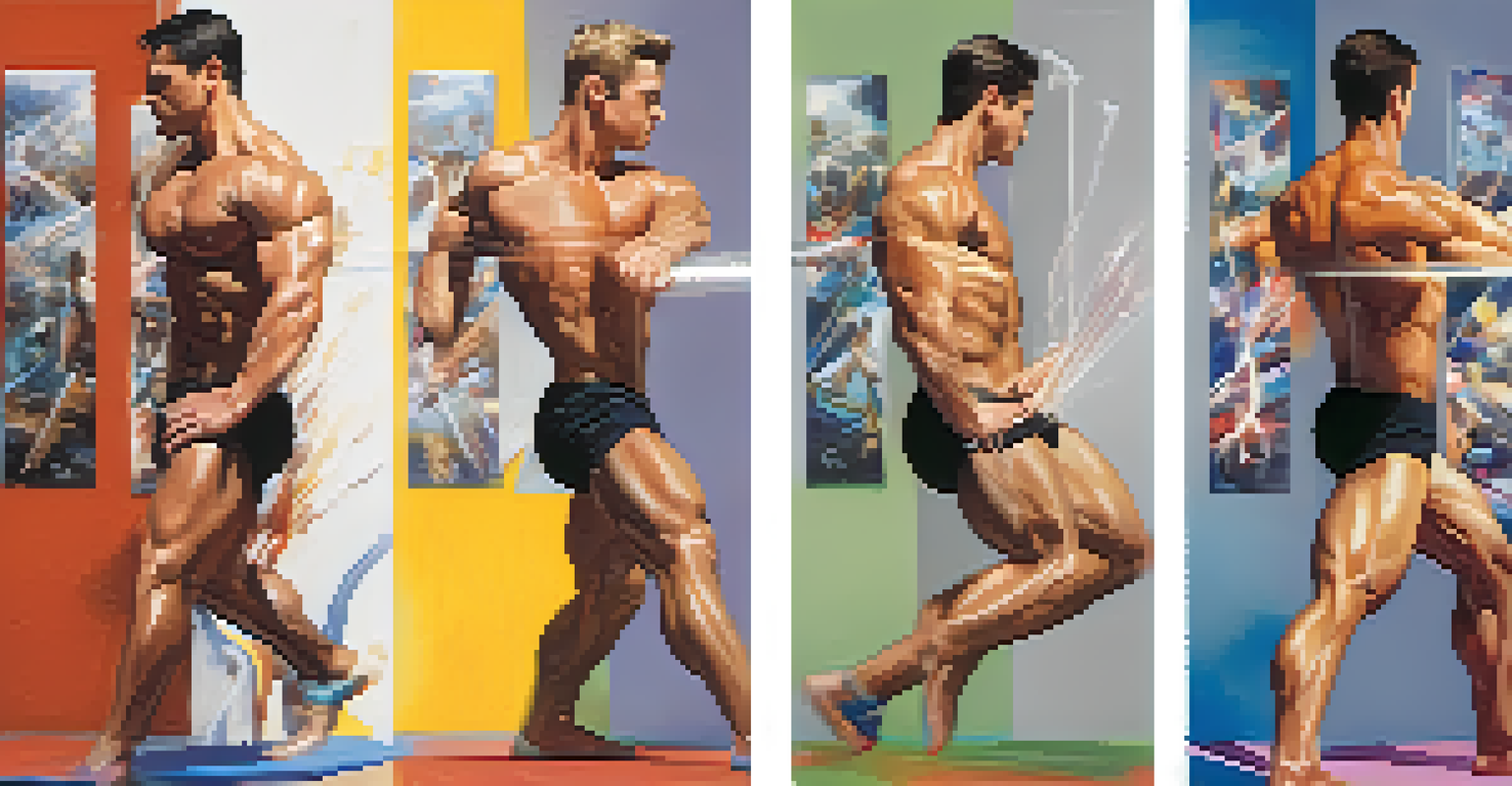Dynamic vs Static Stretching: What Bodybuilders Need to Know

Understanding Dynamic Stretching: The Basics
Dynamic stretching involves active movements that engage your muscles and joints. Unlike static stretching, where you hold a position, dynamic stretches are about movement and getting your body ready for action. These exercises are typically performed before a workout to warm up the muscles and improve flexibility.
Flexibility is the key to stability.
For bodybuilders, dynamic stretching can enhance performance by increasing blood flow and activating the muscles you'll be using. Imagine preparing for a big lift; your muscles need to be primed and ready to go. Dynamic stretches can help achieve this by mimicking the movements you'll perform during your workout.
Examples of dynamic stretches include leg swings, arm circles, and walking lunges. Incorporating these into your warm-up can lead to better range of motion and potentially prevent injuries. The key takeaway here is to get your body moving and ready for the heavy lifting ahead.
The Role of Static Stretching in Bodybuilding
Static stretching, on the other hand, involves holding a stretch for a period, usually between 15 to 60 seconds. This technique is typically used after workouts to help cool down and improve flexibility over time. Think of it as giving your muscles a chance to relax and unwind after the intense work they've just done.

For bodybuilders, static stretching can be beneficial in preventing muscle tightness and soreness. After pushing your limits, your muscles may feel tight, making it essential to incorporate stretches that promote relaxation. This cool-down phase allows your body to recover and prepare for the next training session.
Dynamic Stretching Preps Muscles
Dynamic stretching effectively warms up muscles and increases flexibility before workouts.
Common static stretches include reaching for your toes, the butterfly stretch, or holding a quad stretch. By making static stretching a regular part of your routine, you can enhance your overall flexibility and support muscle recovery, which is crucial for continuous progress in bodybuilding.
Dynamic vs Static: When to Use Each Stretching Technique
Knowing when to use dynamic or static stretching is crucial for maximizing your bodybuilding routine. Generally, dynamic stretching is best suited for your warm-up before workouts, while static stretching should be reserved for the cool-down phase afterward. This approach allows you to prepare your muscles for exertion and then help them recover.
The more you stretch, the more you can stretch.
For example, if you're about to do squats, dynamic stretches like leg swings will help activate your hip flexors and quads. In contrast, after finishing your workout, static stretches targeting those same muscle groups can aid in recovery. This strategic timing ensures your muscles are primed for performance and also receive the care they need afterward.
By adhering to this guideline—dynamic before, static after—you can create a balanced stretching routine that supports both performance and recovery. This dual approach not only enhances your workout but also contributes to your long-term bodybuilding goals.
Benefits of Dynamic Stretching for Bodybuilders
Dynamic stretching offers a range of benefits tailored for bodybuilders. First and foremost, it enhances mobility and flexibility, helping you achieve deeper ranges of motion during lifts. This improved range can lead to more effective workouts and better results over time.
Additionally, dynamic stretching activates the neuromuscular system, which plays a vital role in coordination and balance. For bodybuilders, having a well-coordinated body can make a significant difference during heavy lifts and complex movements. Think of it as tuning an instrument; a well-tuned body performs better.
Static Stretching Aids Recovery
Static stretching promotes muscle recovery and improves flexibility after intense workouts.
Moreover, incorporating dynamic stretches can also elevate your heart rate, preparing your cardiovascular system for the physical demands of your workout. Increased blood flow means your muscles are getting the oxygen they need to perform optimally. Overall, dynamic stretching can set a positive tone for your training sessions.
Statically Stretching: Key Benefits for Muscle Recovery
Static stretching is a powerful tool for muscle recovery, especially after intense bodybuilding sessions. By holding stretches, you're promoting blood flow to the muscles, which aids in the removal of metabolic waste products accumulated during exercise. This process can reduce soreness and speed up recovery time, allowing you to hit the gym harder next time.
Moreover, static stretching helps improve overall flexibility, which is essential for bodybuilders aiming for optimal performance. Increased flexibility can lead to better form and technique, minimizing the risk of injuries. Imagine being able to perform your lifts with greater ease; that's the power of flexibility.
Incorporating static stretching into your routine not only enhances recovery but also contributes to your long-term training goals. Over time, you'll notice increased flexibility, which can lead to enhanced performance in the gym. So, don’t overlook the importance of a good static stretching routine post-workout.
Combining Dynamic and Static Stretching: A Winning Strategy
Combining both dynamic and static stretching can create a well-rounded approach to your training routine. Start your workout with dynamic stretches to prepare your muscles for action, then finish with static stretches for recovery. This combination ensures that your muscles are primed for performance and well-cared for afterward.
By integrating both techniques, you can enhance your flexibility and mobility, which are crucial for any bodybuilder. Think of it as a one-two punch: dynamic stretches get you ready to lift, while static stretches help you recover afterward. This balance is key to achieving your bodybuilding goals effectively.
Combine Techniques for Best Results
Integrating both dynamic and static stretching optimizes performance and recovery in bodybuilding.
A simple routine could include 10-15 minutes of dynamic stretching before your workout and 10-15 minutes of static stretching afterward. This structured approach not only optimizes your performance but also fosters a deeper connection between your mind and body during your training journey.
Final Thoughts: Prioritize Stretching for Bodybuilding Success
In conclusion, both dynamic and static stretching play vital roles in a bodybuilder's routine. Understanding the differences and knowing when to use each technique can significantly impact your performance and recovery. Prioritizing stretching is not just about flexibility; it’s about enhancing your overall bodybuilding experience.
Remember, dynamic stretching is about warming up and preparing your muscles, while static stretching focuses on recovery and flexibility. By incorporating both into your routine, you create a more effective and holistic approach to your training. This balance can lead to better results and a more enjoyable experience in the gym.

So, the next time you hit the gym, don’t skip the stretching. Embrace both dynamic and static stretches to unlock your body’s full potential, paving the way for long-term success in your bodybuilding journey.